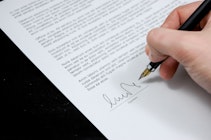How to Write a Business Letter for 2026
All products and services featured are independently selected by WikiJob. When you register or purchase through links on this page, we may earn a commission.
- Why Do People Write Business Letters?
- How to Write a Business Letter: A Step-By-Step Guide
- Other Things to Consider When Formatting Your Business Letter
empty
empty
empty
- Example Template Business Letter
- Top Tips on How to Write a Business Letter Effectively
empty
empty
empty
empty
empty
empty
- Mistakes to Avoid
empty
empty
empty
empty
empty
- Final Thoughts
A business letter is a formal document sent from a company to an external party, be it another business or organization, a client, or a customer. They can also be sent internally to company employees.
Though not as common as email correspondence, they still have their place in the corporate world and, when used, should be formatted, structured and written with professionalism.
This article explains how to write a business letter and includes a template demonstrating the correct business letter format.
Why Do People Write Business Letters?
On a day to day basis, email is the preferred method of communication in most business settings. However, business letters are considered as more official, and that makes them better suited in a range of professional circumstances.
They can be solicited or unsolicited, that is to say, you may be asked by a third party to provide information in an official letter format, or you may send a business letter speculatively in the hope of achieving a specific goal.
You may need to use a formal business letter format when:
- Informing employees of any official changes within your company
- Settling a dispute, either internal or external
- Notifying customers of a specific action, such as changes to an agreement or a cancellation of contract
- Responding to a request for a letter of recommendation or an employment verification letter
- Approaching potential clients with a speculative sales pitch
- Applying to an official organization for financial assistance, such as a business loan
You may also need to use a business letter format as an individual, for example, when writing a letter of intent for an unsolicited job application, when asked to provide a character reference or when producing a resignation letter.

How to Write a Business Letter: A Step-By-Step Guide
Each of the following sections should appear in the official business letter format in the order in which they are listed.
Step 1. Letterhead/Sender Details
Many businesses will make use of letterheaded paper for official communication. This will include company details and often a business logo.
In the absence of a letterhead, be sure to include your business address/contact information at the very top of your letter, including your phone number and email address.
This should include the company name but does not need your name as this will be detailed in the closing section.
Step 2. Date
Under the sender details, insert the date on which your letter was completed.
This should read in the standard US format, with the month written in full, followed by the day, a serial comma and then the year.
For example:
September 18, 2025
Step 3. Recipient Details
The next step is how to address a business letter.
If you’re writing to someone specific, include all information known to you; for example, the recipient’s name with the correct personal title (Mr, Mrs, Ms, Dr, etc.) and job title.
If the recipient is female and you are not sure of their title, 'Ms' is generally considered the best option to go for.
This should be followed by the company name and full address, including state and zip code.
Step 4. Salutation
Next, include a greeting.
Address the recipient as ‘Dear’ and use the same personal title and surname as written in the recipient details, followed by a colon (for example, ‘Dear Mr. Smith:’)
In some circumstances, it may be acceptable to use the salutation 'To Whom It May Concern' or 'Dear Sir', but generally speaking this is best avoided, since it shows a lack of effort on the senders part to find out more information on who they are writing to.
Step 5. Subject Line
A subject line is optional but can be beneficial if you want to immediately highlight the nature of the letter or any associated information (for example, a reference number).
If including a subject line, keep it left aligned when using the block business letter format, or centered for modified and semi-block styles.
Step 6. Body of the Letter
The main body paragraphs of your business letter should be clear, concise and to the point.
Begin with a short paragraph detailing your intent. Explain why you are writing to the recipient and what it is you are looking to achieve.
If your letter is in response to a request, explain exactly what it is you are responding to.
In the following paragraphs, include relevant background information and any details needed to support your letter. Try and keep this section to two or three paragraphs at most by using plain language and staying on topic.
Your last paragraph should reinforce your intent and, where necessary, include a call to action that lets the recipient know exactly what they should do next and, if appropriate, where to follow up.
Step 7. Closing
Sign off your letter with an appropriate close.
The best closing to use will depend on the extent of the relationship between yourself and the recipient.
As a general rule, use ‘Yours truly’ when there is no existing relationship, and ‘Respectfully yours’ if you are known to the recipient but still need to maintain a level of formality.
‘Sincerely’ or ’Best regards’ is more commonly used when the sender and recipient are known to each other in a personal context and is considered less formal.
It may also be appropriate for ending your letter in a friendly tone; for example, if you were writing to a customer in response to a complaint and wanted to sound official yet also understanding and apologetic.
Only capitalize the first letter of your closing, follow with a colon and leave four line spaces after for your signature.
Step 8. Signature
Type your full name, job title and company.
Printed letters sent by mail should be hand-signed in the space between the closing and signature lines.
If sending your business letter electronically, you may opt to use a digital signature. Again, leave four line spaces between the signature line and any additional information, such as enclosures.
Step 9. Enclosures and CCS
If you are sending supporting documentation with your letter, list these in an enclosures section below the signature line.
If there are multiple attachments, be sure to list them individually, each on its own line.
Additionally, if your letter has more than one recipient, list each of these under a CC heading with one line for each name.
For example:
Enclosures:
Application form
Financial statements
Business proposal

Other Things to Consider When Formatting Your Business Letter
There are three key points to the formal business letter format. These are font (both style and size), spacing and format type.
1. Font
An official letter should be both easy to read and professional in appearance, so choose your font style carefully.
Steer clear of over-stylized types as these can appear informal and amateurish.
Commonly used fonts for official documents include those from the serif family, such as Times New Roman, Garamond and Georgia, or those from the sans-serif family, including Arial, Helvetica and Calibri.
The font size should be between 10 and 12 points.
2. Spacing
White space/blank lines are is an important element of the business letter format as it makes the document easier to scan and generally more accessible to the reader.
There should be a one-inch margin around all edges, a single line space between each section of the letter until your closing statement and a double space between each paragraph.
You should leave four line spaces between your closing and signature line and an additional four line spaces thereafter if listing enclosures.
Do not indent your paragraphs and use single spacing for the text.
3. Format Style
When deciding how to format a business letter, you should first check if your company or organization has a standardized method. If so, this should be used for consistency.
There are three commonly used format styles:
- Block format – All content is left-justified
- Modified block format – All content is left justified except for your details (name and address), the date, and the closing, which are centered
- Semi-block format – This uses the modified block business letter format, with the starting line of each paragraph indented
All styles are acceptable, but block format is the most common, so stick to this style if you’re unsure.
Example Template Business Letter
The following sample business letter format shows each section as it should appear, written as a letter of recommendation where Company A is the sender, and Company B the recipient.
Company A
[Street Name]
[City]
[State]
[Zip Code]September 21, 2025.
Ms. Walker
Head of Sales
Company B
[Street Name]
[City]
[State]
[Zip Code]Dear Ms. Walker:
It gives me great pleasure to recommend Anthony Knight for the role of Client Account Manager within the sales team at Company B.
As Anthony’s team leader, I have overseen his employment in the position of Sales Representative at Company A for the last five years. During his time with us, Anthony has shown himself to be a valuable member of the team, with a commitment to business growth.
Anthony has never failed to meet and exceed expectations, both in terms of sales targets and teamwork. His personal record shows a consistent over target performance, whilst his co-workers have voted him team member of the month on several occasions.
With a client-focused mindset, Anthony’s success in sales stems from his outstanding levels of customer service, and he has played a significant role in increasing repeat business by 25% over the last two years.
Anthony is a pleasure to work with and it is with great confidence that I recommend him. I do not doubt that he will prove a valuable asset to your team.
Should you need any further information please don’t hesitate to contact me again. I would be more than happy to provide further detail on Anthony’s achievements at Company A.
Yours truly,
David Howard
Client Services Team Leader, Company A
Top Tips on How to Write a Business Letter Effectively
When it comes to how to write a business letter, there are a few guidelines you should follow to produce a document that is both professional and effective:
Keep It Short
Business letters should get straight to the point and ideally be no more than one page in length.
Whoever the recipient, chances are they have a busy schedule and if your letter rambles on, they’re unlikely to take the time to read it.
Use Formal Language and Stick to the Facts
A business letter is not the place to air feelings and emotions. It is a means of communicating a professional message. So, use appropriate language and focus on factual information.
Avoid slang terms and phrases or overfamiliarity. It’s OK to be friendly in tone, just remember this is a business conversation and should read as such.
In the same vein, don’t go over the top with formalities. Phrases such as 'as per our conversation' can come across as abrupt, and words like 'hereafter' sound archaic.
Speak to the Reader
When drafting out your business letter, consider it from the recipient’s perspective.
It’s all too easy to zone in on your own point of view and not consider your message in a wider context.
It’s vital to state your intent and this should be done as soon as possible, but you also need to add value for the reader at the same time.
Ask yourself what key messages you want them to take away and how these can be best delivered.
Proofread
No matter how small they may seem, mistakes will detract from the professionalism of your business letter. Be sure to proofread thoroughly and for added peace of mind, have a colleague check over it too.
A second pair of eyes is not only good for catching errors, but it is also useful for ensuring your letter reads well and is clear in its messaging.
End with a Strong Call to Action
If your letter is intended to prompt action, let the recipient know exactly what it is you want them to do.
It may seem presumptuous to assume they’ll be interested in what you’re offering, but a vague closing statement will only leave the reader confused and do little to help you achieve your goal.
Get Them Out on Time
Most business letters will serve some sort of purpose that has implications, either for your business, yourself or another individual.
Make sure they are completed and sent far enough in advance to reach the recipient in plenty of time.
Delays could mean financial losses, a missed opportunity, or at worst, bring legal ramifications.
Mistakes to Avoid
Including Too Much Detail
As mentioned, your business letter should be concise and to the point and should not be weighed down with excessive facts or figures.
Where substantial supporting information is required, it should be sent as additional documentation and referred to within the body of your letter.
Using Redundant Words and Phrases
Again, this comes down to keeping your letter succinct. Business writing should not be descriptive or complex.
If you are using a drawn-out phrase where a single word would suffice, you run the risk of losing the reader’s attention.
Using Industry Jargon
You may think business speak has a place in the official business letter format, but overused buzzwords and jargon do not make for persuasive writing.
Keep your language formal and use plain English that is transparent and clearly communicates your intentions.
Abbreviations
Do not assume that the recipient will understand abbreviations or acronyms. Type all words, titles, organizational names, etc. in full.
If the recipient is within your company or industry sector, they will likely have the relevant knowledge, but you want to be sure their attention is focused on your message, not checking definitions.
Grammatical Errors and Inconsistencies
It goes without saying that you should avoid errors at all costs, particularly grammatical ones that indicate you have not paid attention to the finer details of your letter. This suggests sloppiness and will make you look unprofessional.
You should also avoid any inconsistencies. For example, if you’ve capitalized a particular word within your letter, be sure to use the same capitalization every time it appears throughout.
Final Thoughts
Understanding the official letter format and how to write a business letter well is a key professional skill.
Whilst not something you will do every day, or indeed every year, you should still equip yourself with the knowledge to do so.
After all, business letters are often needed on short notice, so you need to be prepared.
Pay close attention to content to ensure it is fit for purpose, and always follow an accepted business letter format to present yourself in the most professional light possible.




